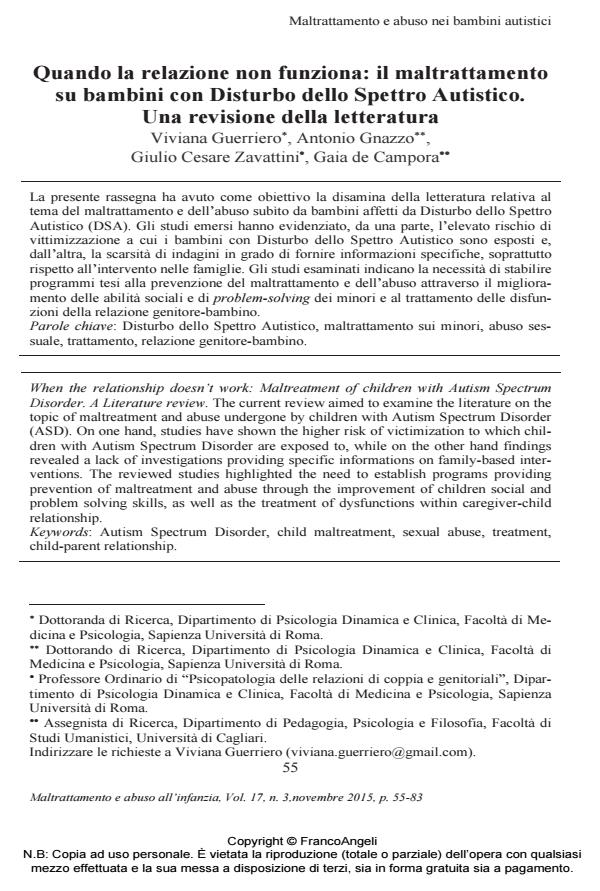Quando la relazione non funziona: il maltrattamento su bambini con Disturbo dello Spettro Autistico. Una revisione della letteratura
Titolo Rivista MALTRATTAMENTO E ABUSO ALL’INFANZIA
Autori/Curatori Viviana Guerriero, Antonio Gnazzo, Giulio Cesare Zavattini, Gaia de Campora
Anno di pubblicazione 2015 Fascicolo 2015/3
Lingua Italiano Numero pagine 29 P. 55-83 Dimensione file 167 KB
DOI 10.3280/MAL2015-003004
Il DOI è il codice a barre della proprietà intellettuale: per saperne di più
clicca qui
Qui sotto puoi vedere in anteprima la prima pagina di questo articolo.
Se questo articolo ti interessa, lo puoi acquistare (e scaricare in formato pdf) seguendo le facili indicazioni per acquistare il download credit. Acquista Download Credits per scaricare questo Articolo in formato PDF

FrancoAngeli è membro della Publishers International Linking Association, Inc (PILA)associazione indipendente e non profit per facilitare (attraverso i servizi tecnologici implementati da CrossRef.org) l’accesso degli studiosi ai contenuti digitali nelle pubblicazioni professionali e scientifiche
La presente rassegna ha avuto come obiettivo la disamina della letteratura relativa al tema del maltrattamento e dell’abuso subìto da bambini affetti da Disturbo dello Spettro Autistico (DSA). Gli studi emersi hanno evidenziato, da una parte, l’elevato rischio di vittimizzazione a cui i bambini con Disturbo dello Spettro Autistico sono esposti e, dall’altra, la scarsità di indagini in grado di fornire informazioni specifiche, soprattutto rispetto all’intervento nelle famiglie. Gli studi esaminati indicano la necessità di stabilire programmi tesi alla prevenzione del maltrattamento e dell’abuso attraverso il miglioramento delle abilità sociali e di problem-solving dei minori e al trattamento delle disfunzioni della relazione genitore-bambino.
Parole chiave:Disturbo dello Spettro Autistico, maltrattamento sui minori, abuso sessuale, trattamento, relazione genitore-bambino.
- Sintonie e dissintonie nei legami precoci: traiettorie di valutazione e considerazioni cliniche nei contesti ad alto rischio per lo sviluppo infantile Simona Di Folco, Gaia de Campora, Giulio Cesare Zavattini, in MALTRATTAMENTO E ABUSO ALL'INFANZIA 2/2016 pp.71
DOI: 10.3280/MAL2016-002005
Viviana Guerriero, Antonio Gnazzo, Giulio Cesare Zavattini, Gaia de Campora, Quando la relazione non funziona: il maltrattamento su bambini con Disturbo dello Spettro Autistico. Una revisione della letteratura in "MALTRATTAMENTO E ABUSO ALL’INFANZIA" 3/2015, pp 55-83, DOI: 10.3280/MAL2015-003004